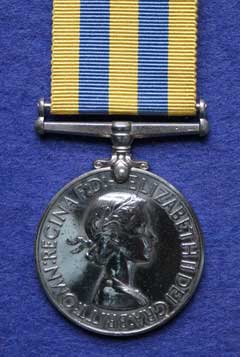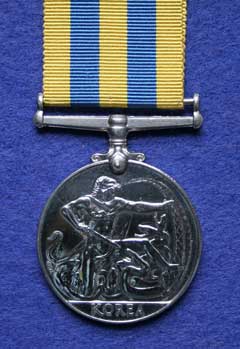 |
King's Own Royal Regiment Museum Lancaster |
|
|
HOME Museum & Collections Sales Donations Events Contact Us REGIMENTAL HISTORY 17th Century 18th Century 19th Century 20th Century First World War Second World War Actions & Movements Battle Honours FAMILY HISTORY Resources Further Reading PHOTO GALLERY ENQUIRIES FURTHER READING LINKS |
MEDAL INFORMATION Korea Medal 2 July 1950 to 10 June 1953
Face
Reverse
Size
Composition
Ribbon
Suspension
Naming
Bars
Awarded The Korean War resulted from the crossing of the 38th Parallel and invasion of the Republic of Korea (South Korea) by the forces of the Democratic Peoples Republic of Korea (North Korea) on 25th June 1950. The South, which had no air force and only an untrained and lightly-armed army, was no match for the North, backed by the Soviet Union, and the United Nations called for the raising of a multi-national force in support of the South. The force, lead by the American General Douglas MacArthur, was the first of its kind to operate under the flag of the United Nations. The British Government, although initially reluctant to participate, eventually provided a force which was second only in size to that of the USA among those nations supporting South Korea, and suffered over one thousand dead and over 2 300 wounded in the conflict. Although hostilities ceased on 27th July 1953 British troops serving in Korea in a peace keeping role beyond that date up until 24th July 1954 also qualified for the United Nations medal for Korea.
The King’s Own The 1st Battalion The King’s Own Royal Regiment (Lancaster) did not serve as a unit in Korea during the hostilities, but provided drafts of men who served with The Royal Ulster Rifles, The Gloucestershire Regiment, The Welch Regiment and The King’s Regiment (Liverpool). Those men were awarded the Korea Medal and the medals were named to them as “King’s Own”. Korea Medals in the museum's collection
|


